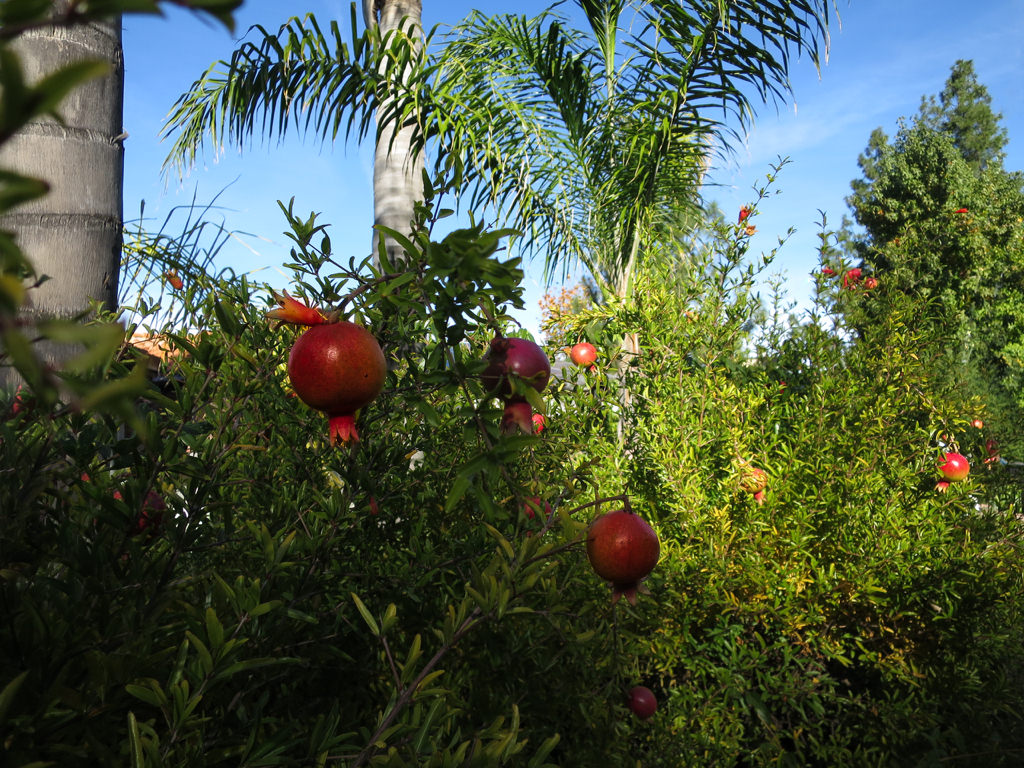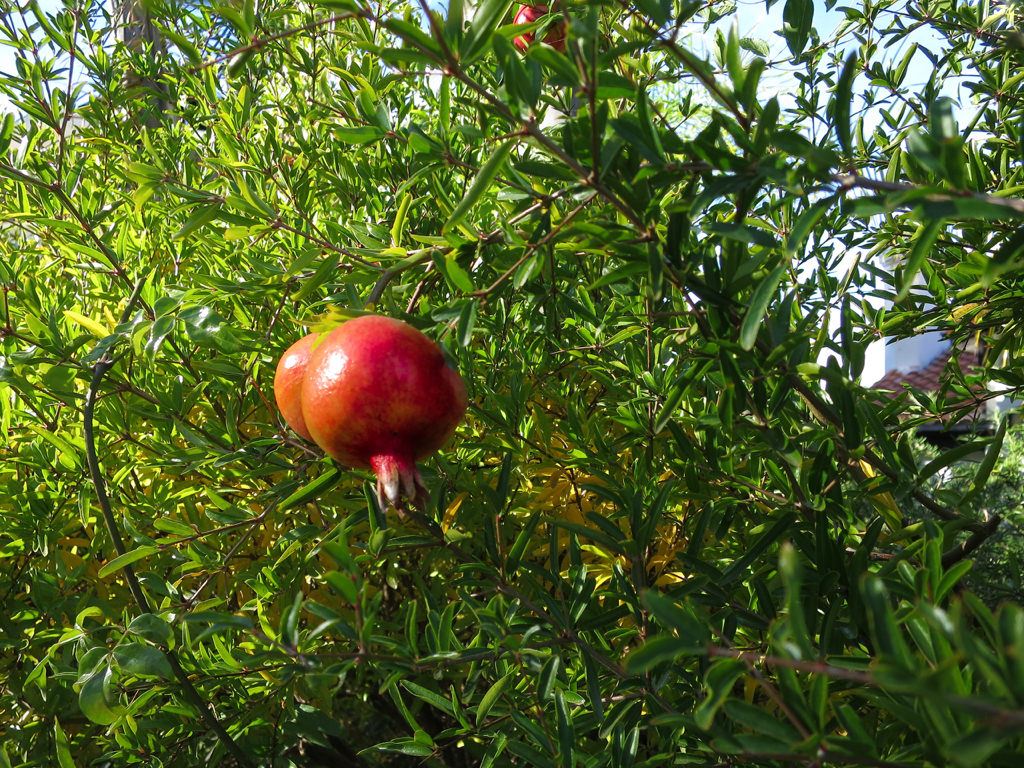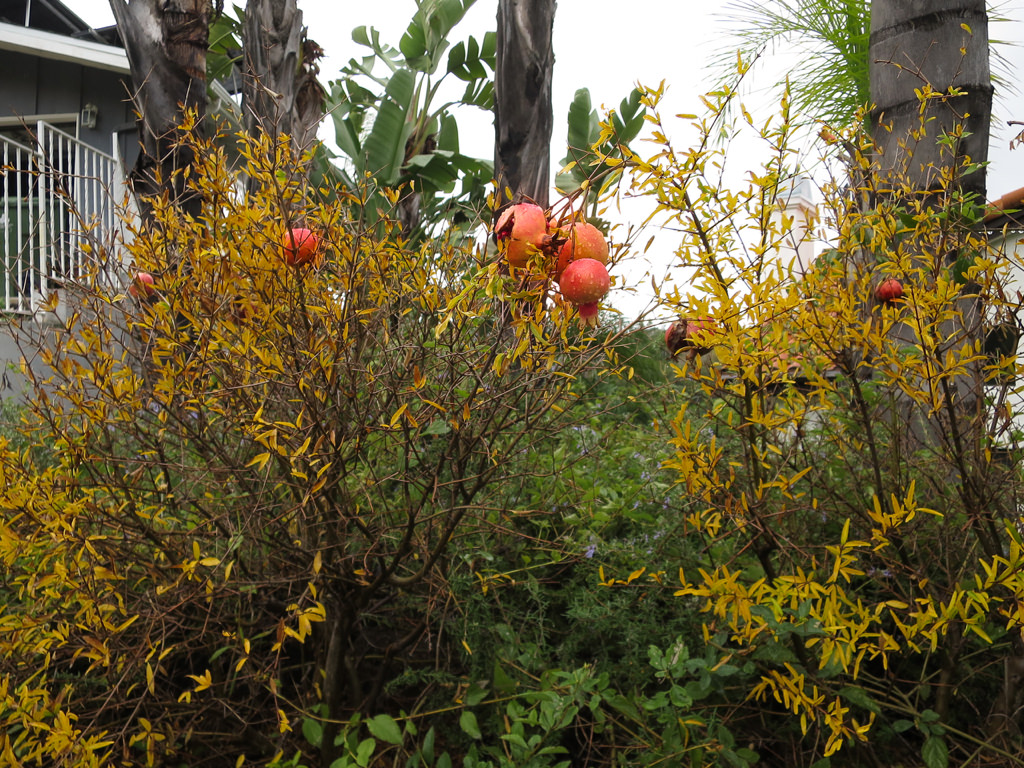Punica granatum ’Nana’
Dwarf Pomegranate, Pomegranate ‘Nana’, Carthaginian Apple ‘Nana’, Granada ‘Nana’

Pomegranate is a fruit tree of antiquity, going back to Persia about 4,000 years ago. Pomegranate enabled lively trade between urbanized areas of Ancient Eurasia, for the fruit’s juicy seeds were a source of liquid and nutrients, and sustained merchants on their long journey while trading raw materials and precious items from distant regions of the Persian Gulf to the Mediterranean.
On such long journeys, the whole Pomegranate fruit would be stored in a leather bag and dry seeds in a pouch. When a Sumerian loads bulging bags of Cochineal insect on his camel, he reserves a special place for the invaluable leather bag with pomegranates, and nibbles on the seeds during the long trek from South Mesopotamia to Egypt.
When the Sumerian reached the boisterous market of So’oud Atun, he traded in sought-after kermes dye for…perhaps enigmatic emeralds or spellbinding malachite. It happened that adjacent to his display of carmine shines a spread of glimmering sky-blue ultramarine stones. These had been brought on donkey cavalcades from Eskazer through the Dorah Pass in Hindu Kush Himalayas to the Indus River, and once they reached the Arabian Sea, sailed on dhows to Egypt. Pomegranate was essential food during this lively trade. One may say that Egyptian tombs are graced with the calming elegance of Lapis Lazuli thanks to the Pomegranates.
Around the 16th century, the plant was brought to North America from Spain, and the hardy prolific ancient fruit tree made this continent its home. Even today, Pomegranate's unusually shaped fruit is valued for its exceptional flavor and texture. Furthermore, both the tree and shrub are poor soil and drought-tolerant, and easy to grow. Notably, the plant copes well with extreme heat and will survive alkaline soil that would kill most plants.
From many varieties, ‘Wonderful’ is the best-known fruiting 10-foot fountain-shaped deciduous shrub, tree, or espalier. From dwarf varieties, three-foot tall and wide 'Nana' is sought after for its showy orange-red flowers, which are followed by bright orange-red ornamental fruit.
Quick facts for 'Nana'
Height: 2 to 4 feet
Width: 2 to 4 feet
Spacing: 3 to 4 feet
Leaves: deciduous
Soil: clay, loam, sand, well-drained
pH: acid, alkaline, neutral
Exposure: full sun
Water: low to average
Tolerance: drought and heat tolerant
Toxicity: not toxic
Wildlife: attracts hummingbirds, bees, and birds


References
Finlay, V. (2004). Color: A Natural History of the Palette (pp. 310, 312). Random House Trade Paperbacks.
Gardenia. (n.d.). Punica granatum var. nana (Dwarf Pomegranate). https://www.gardenia.net/plant/punica-granatum-pomegranate-nana
Gershon, L. (2021, April 9). Archaeologists in Egypt Discover 3,000-Year-Old ‘Lost Golden City’. Smithsonian Magazine. https://www.smithsonianmag.com/smart-news/archaeologists-discover-3400-year-old-egyptian-city-180977471/
Shigley, J. (2017, May 23). Historical Reading: The Ancient Emerald Mines of Egypt. GIA. https://www.gia.edu/UK-EN/gia-news-research/historical-reading-ancient-emerald-mines-egypt
Spengler, T. (2022, March 21). Learn about the history of pomegranates. Gardening Know How. https://www.gardeningknowhow.com/tbt/history-of-pomegranates
Sunset Publishing Corporation. (1996). Western Garden Book (p. 445). Menlo Park, CA: Sunset Books and Sunset Magazine.
The History of the World (1st ed.). (1999). (pp. 54, 55). Harper Collins Publishers.
Trees of Antiquity. (n.d.). Wonderful Pomegranate. https://www.treesofantiquity.com/products/wonderful-pomegranate